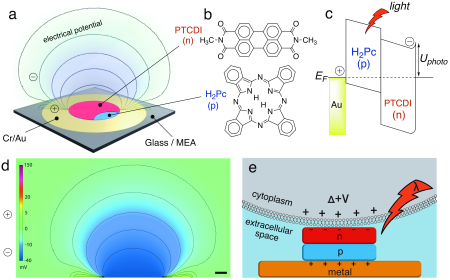Localized stimulation of neurons in a safe and effective way is important for both research and therapeutic purposes. The currently available solutions based on micro- and nano-electrodes as well as on ion delivery platforms for neuronal electrical communications led to bioelectronic therapies and opened a new window of research in neuroscience. An important limitation of this approach is the need for wiring the electrode at the site of neurostimulation. The motivation for wireless access to the stimulation site has led to optogenic approaches, necessitating genetically modified targeted neurons for the expression of light sensitive ion channels. Conventional approaches to addressing the wireless connectivity problem that does not include genetic modification include photoelectric stimulation in which the silicon solar cell of micrometric dimensions is attached to the neuronal excitation electrodes. These solutions are used in clinical applications as artificial retinas that are implanted into blind patients with damaged photoreceptors in the retina.

Electric field distribution arround the electrode for direct photocapacitive stimulation a) and d) made of b) organic pigments of p-type (H2PC) and n-type (PTCDI). c) Energy diagram of the electrode, e) schematic representation of the electrode operation.
A new approach to electrical stimulation of neurons comes from the Organic Electronics Laboratory from the University of Linköping in Sweden. Scientists in the group of prof.dr. Eric Glowacki, in which CEMS member Vedran Đerek participated as a post-doctoral student, presented a new approach to photoelectric stimulation of neurons using thin layers of organic semiconductors – cheap pigments used in cosmetics and the color industry (Advanced Materials, https: //doi.org/10.1002/adma.201707292). These pigments represent a class of new functional materials that are stable under physiological conditions, so they do not need to be protected from water encapsulation influence. The nature of the stimulus is completely capacitive, meaning that active materials – pigments – do not participate in chemical reactions during stimulation, therefore the device is persistent and can not introduce harmful substances into the body. The working principle was demonstrated by associates from prof.dr. Hanein group from Israel on the model of blind chicken retina, where in-vitro neurostimulation of retina neurons was demonstrated.
The Robin Hood Solver software package was used to calculate the three-dimensional distribution of electric potential around the photo-capacitive excitation electrode, which was provided by one of the authors of the package, dr. Predrag Lazić from IRB. The successful advancement of CEMS in the bioelectronic direction with the use of new functional materials can be a motivation for future research in which it would be possible to use the previously developed and explored materials within the framework of CEMS.
Foto: Thor Balkhed, LiU
Illustration source: https://doi.org/10.1002/adma.201707292
